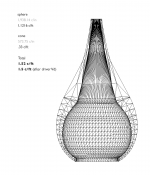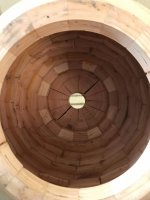Hey everyone. A woodcraftsman friend has asked me to help design and construct a down-firing sub enclosure made of stacked wood rings with a Dayton UM22-10 mounted up.
Here is a diagram of the 3D shape standing up.

I took some inspiration from the shape of a B&W 800D and tried to carry it over to a downfiring ported subwoofer but i'm concerned with the design of enclosure interior and size of port.
The enclosure is made of stacked rings that form 'steps' on the inside. see these photos of an older throwaway proof of concept:

I had originally planned to smooth out the interior as it looks in the rendering, but I wanted to get some opinions on whether it would be worth it or whether maybe these 'steps' would work as additional angles that would diffuse waves inside before reaching the port at the top?
RE the port, currently the design specs the port at 2" diameter round, will this be large enough or should we forgo a few rings at the top to get closer to a 3" diameter port?
Apologies for the noobish questions, I'm a bit out of my league on the underlying science here.
Here is a diagram of the 3D shape standing up.

I took some inspiration from the shape of a B&W 800D and tried to carry it over to a downfiring ported subwoofer but i'm concerned with the design of enclosure interior and size of port.
The enclosure is made of stacked rings that form 'steps' on the inside. see these photos of an older throwaway proof of concept:

I had originally planned to smooth out the interior as it looks in the rendering, but I wanted to get some opinions on whether it would be worth it or whether maybe these 'steps' would work as additional angles that would diffuse waves inside before reaching the port at the top?
RE the port, currently the design specs the port at 2" diameter round, will this be large enough or should we forgo a few rings at the top to get closer to a 3" diameter port?
Apologies for the noobish questions, I'm a bit out of my league on the underlying science here.
The larger port will reduce port velocity (good). You must also deduct the port volume from the net volume, which will require a slightly larger "bulb".
Thank you! Wondering if you would count the entire "cone" above the bulb as the port? or does any of the cone volume count towards the net volume? Wondering because the bulb will have to be considerably larger to account for the subtraction of the cone volume.
If you count the entire "cone" above the bulb as the port, the box has become a sort of "transmission line" as GM mentioned.1)Wondering if you would count the entire "cone" above the bulb as the port?
2)or does any of the cone volume count towards the net volume?
2) Any portion of the box not contained in the port area counts towards the net volume.
You've morphed a box + vent into a 1/4 WL TL [TQWT], so needs to be simmed as such, which will require a fairly accurate internal dimensional drawing to input.
GM
These are all the measurements needed to calculate internal volume as far as I can tell:
Imgur: The magic of the Internet
How would you go about simming this design? Does WinISD work for a 1/4 WL TL TQWT? On a mac and i haven't set up a virtual machine yet to test it out.
I would sim this in Hornresp, I would take the red sphere as the volume of the Vtc (in cm^3), minus the volume occupied by the driver. Then take the conical part, as a single segment (S1 - S2 - L12) roughly between the 8.4" surface area and 3" surface area.
Tools - Output - Horn
Tools - Particle velocity - Horn Mouth
If you give all the inputs, I'm sure someone is willing to sim it for you.
Regards
Tools - Output - Horn
Tools - Particle velocity - Horn Mouth
If you give all the inputs, I'm sure someone is willing to sim it for you.
Regards
- Status
- This old topic is closed. If you want to reopen this topic, contact a moderator using the "Report Post" button.
- Home
- Loudspeakers
- Subwoofers
- Horn-shape wood sculpture sub enclosure issues